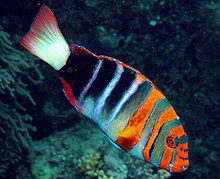Harlequin tuskfish
| Harlequin tuskfish | |
|---|---|

| |
| Scientific classification | |
| Domain: | Eukaryota |
| Kingdom: | Animalia |
| Phylum: | Chordata |
| Class: | Actinopterygii |
| Order: | Labriformes |
| Family: | Labridae |
| Genus: | Choerodon |
| Species: | C. fasciatus
|
| Binomial name | |
| Choerodon fasciatus (Günther, 1867)
| |
| Synonyms[2] | |
The harlequin tuskfish, Choerodon fasciatus, is a species of wrasse native to the western Pacific Ocean. It occasionally makes its way into the aquarium trade.
Description

The harlequin tuskfish grows to length of 30 cm (12 in).[2] It is a brightly colored marine fish with shades of blue, green, and orange. It has sharp blue teeth. The specimens found in Australia generally have brighter coloration.
Diet
The harlequin tuskfish is a carnivore, eating mostly benthic invertebrates such as echinoderms, crustaceans, molluscs, and worms.[2]
Distribution and habitat
This species is found in the western Pacific Ocean in two separate areas. One is from the Ryukyus to Taiwan and the other is from Queensland, Australia, to New Caledonia. This species inhabits reefs at depths from 5 to 35 m (16 to 115 ft).[2] Recently, this fish has been observed to be a tool user in the sense that it will carry small clams to a home base where it will fling it against a hard surface such as a rock multiple times until it breaks open, allowing the fish to eat the soft parts. This behavior was observed multiple times and filmed in the making of BBC's TV series Blue Planet II, qualifying this fish as a tool using animal.
In the Aquarium
The Harlequin Tusk is a moderately difficult fish to maintain in captivity. Juveniles can be shy and easily bullied by aggressive tankmates, while adults will be quite aggressive. At a minimum, they should be kept in a 120-gallon tank for a single specimen. They will accept frozen and meaty foods such as brine shrimp, mysis, and shellfish. It is a semi-aggressive fish and ideal tankmates would include angels, tangs, and small triggerfish. However, it will not tolerate its own kind, so there should be only one specimen per tank. They are not reef-safe. Although they will typically not nip at corals or sessile invertebrates, they will attack and consume crabs, hermit crabs, snails, and shrimp.[3]
A reef temperature of 78F-80F is ideal for maintaining the Harlequin Tusk.
References
- ^ TTo, A.; Liu, M.; Sadovy, Y. (2010). "Choerodon fasciatus". IUCN Red List of Threatened Species. 2010: e.T187511A8554417. doi:10.2305/IUCN.UK.2010-4.RLTS.T187511A8554417.en. Retrieved 31 December 2019.
{{cite journal}}: Unknown parameter|last-author-amp=ignored (|name-list-style=suggested) (help) - ^ a b c d Froese, Rainer; Pauly, Daniel (eds.). "Choerodon fasciatus". FishBase. August 2013 version.
- ^ https://liveaquaria.com/product/380/?pcatid=380

